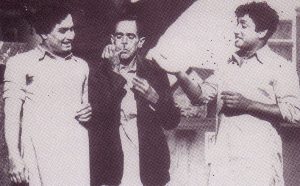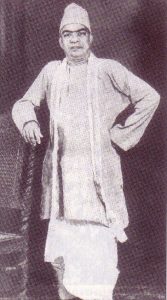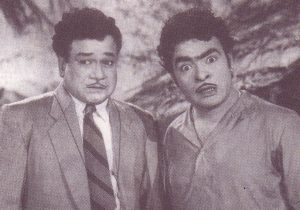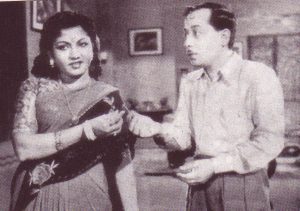Concepts on Humor and Comedians
by Sachi Sri Kantha, June 9, 2019
Correspondence with Kannan on Karunanidhi
For additional clarification on the theme covered in Part 51, I provide the email correspondence (4 items) I had with fellow MGR biographer Kannan. I reproduce these below with his permission.

Koondu Kili movie still – (from Lt) MGR, Friend Ramasamy and Sivaji Ganesan
Item 1: From Kannan to Sachi [email May 17, 2019]
“Dear Sachi,
“As always rich with details. I again learnt things that I did not know before like the Deccan Chronicle article. Kalaignar (M. Karunanidhi) and MGR both mention the role they played in supporting each other in the two films. Here is what Kalaignar wrote in 1984:
‘In an open letter titled ‘I Too Am Offering Prayers’, the DMK patriarch recalled their more than four-decade-long friendship, their sharing a small flat in Coimbatore, their horse cart ride around the town for two annas, and how they ate and hung out together. He reminisced how he had stuck to his recommendation that MGR play the lead role in Mandhirikumari (The Minister’s Daughter, 1950) for which he had penned the dialogues. MGR would reciprocate this gesture by insisting on Kalaignar as the scriptwriter for his Marudhanaatu Ilavarasi (The Princess of Marudha, 1950).’
Also, if I remember correctly in his autobiography MGR mentions the same.”
Item 2: From Sachi to Kannan [email May 17, 2019]
“Dear Kannan,
Thanks a lot for your kind comments. I appreciate it. Your interpretation that MGR and MK mutually supported each other in late 1940s and 1950, can be acceptable to a level. But, in the following year, there is this unpleasant fact.
1951 – Sarvadhikari [The Dictator] movie was produced again by the Modern Theatres. MGR was the hero. But, the script writer was A.V.P. Asaithambi, and not MK. Why MK was sidelined for this movie by T.R. Sundaram, if MGR-MK combination worked perfectly for the previous year’s Manthiri Kumari, we don’t know now.”
Item 3: From Kannan to Sachi [email May 18, 2019]
“Dear Sachi,
I believe it was the only movie for A.V.P. Asaithambi. It was a time when he had been jailed for his ‘Gandhiaar Sandhiyadaiya’ [Let Gandhi rest in Peace] book and tonsured in jail and the DMK made a huge fuss over it. He was a good writer and also a good speaker. He rose to become a leading light of the DMK and was an MLA, MP before he died prematurely.
T.R. Sundaram was in for experiments and the Dravidian movement’s script story writers were Anna and Kalaignar. Asaithambi appeared promising. The movie did well and yet Asaithambi did not get other opportunities. The following year MGR and Kalaignar had come together for Naam [We] produced under the banner Mekala pictures, in which both were partners. That movie did not fare well. MGR came out of Mekala. That very year Parasakthi made waves. Yet in 1954 MGR and Kalaignar were back for Malaikallan [The Mountain Thief]. And this association continued till Engal Thangam [Our Gold] which MGR and Jayalalitha did gratis for Maran and Kalaignar and Maran’s speech later shows how indebted they were to MGR. In 1961, Kalaignar and MGR were together to see Sampath out. Kannadasan’s grouse on MGR on this is vividly etched in his autobiography Vanavasam. Up to 1969 the two had a strong relationship which changed after Kalaignar became CM. Then, there could not be two leaders in that small party.”
Item 4: From Sachi to Kannan [email May 19, 2019]
“Dear Kannan,
Thanks a lot for your thoughts. With your permission, I’ll incorporate your comments in the next chapter for their factual details and clarification.
On Asaithampi, Kannadasan had indirectly commented (somewhat derisively on Asaithambi) in ‘Vanavaasam‘, that in the 1957 election, the seat Asaithambi was assigned and won in Chennai could have been his, but he opted to contest at his native region, and lost.
As per MGR-MK collaboration lasting up to the point of ‘Engal Thangam‘ movie in 1970, I have a different view. You are certainly correct, that their friendship lasted until, MK’s ascension to leadership, after Anna. Both behaved diplomatically until then, and hid their rivalry for reverence to Anna. According to Cho’s memoirs, MGR had his way during the shooting of his final call sheet for the ‘Engal Thangam’ movie for a small scene, by delaying it and kept all concerned in some sort of tough grip. I guess, around that time, MGR was pissed off by MK actively promoting his son Muthu.
MK had trouble even with K.R. Ramasamy, who was sidelined by him. After Anna’s death, K.R.R’s contribution to the development of DMK was obliterated. Do you have any info, about this conflict? I don’t think, MK wrote any scripts for K.R.R’s movies. From what I read, Mrs. Kalyani Ramasamy was good pals with Janaki, and visited her frequently. Even on the day MGR was shot in 1967, Mrs. Ramasamy was at their house.”
MGR’s concepts on humor and links to comedians
It is rather unfortunate that Eric Barnouw and S. Krishnaswamy had neglected to cover the humor and comedy aspects in their pioneering study, ‘Indian Film’. Only the influence of N.S. Krishnan is passingly noted in three short paragraphs. No specific mention was made on humor generating artists (actors, lyricists and script writers) in the movies of other Indian languages. This angle deserves in-depth study by other historians of Indian movies. As for Tamil cinema, a short book ‘Tamil Cinimavil Nagaichuvai Kalaignargal’ (Comedians in Tamil Cinema, 136 pages) authored by V. Ramamurthi appeared in 2008. It offered brief details on the careers of 22 comedians, including 5 women. Excluding the last one mentioned (Kaundamani) in this book, MGR had worked with all 21 comedians. Even in this book, careers of quite a few such as P.D. Sambandam, Pulimootai Ramasamy, K.S. Angamuthu, C.T. Rajakantham and Pakoda Khadar have not been included.
One among the notable Tamil comedians who placed his imprint in the Tamil movies was J.P. Chandrababu (1927-1974) a mercurial, slap-stick comedian, who also could sing and dance well. Though MGR appreciated Chandrababu’s talent, and offered him opportunities in quite a number of his movies since 1955, the relationship between the two was a strained one. Probably, Chandrababu found MGR’s disciplinarian streak, a burden for his care-free life. Nevertheless, of the three movies MGR’s produced, Chandrababu did appear in two – Nadodi Mannan (1958) and Adimai Penn (1969). Script writer Arurdoss had traced the conflicts between these two, in his memoirs.
Kannan’s biography of MGR describes a confrontation that probably happened in 1950s, from comedian J.P. Chandrababu’s angle. To quote, “…everyone except MGR laughed at a joke told by Chandrababu…MGR could not enjoy the joke like the others did, MGR shot back saying that it was so flat that the comedian would have to physically tickle him to get a laugh out of him.”
This episode may project as an arrogant and humor-challenged guy. Without the benefit of learning the context of Chandrababu’s joke, one cannot infer a harsh judgement on interpreted MGR’s lack of humor appreciation. In contrast to this Chandrababu episode, his junior contemporary and comedian Cho Ramasamy had recorded in his memoir that MGR even enjoyed a joke at his own expense. To comprehend the relevance of the joke presented by Cho (translated below), one should know that, Cho was the editor of satire magazine Thuglak, and Kalaimagal (a Tamil literary magazine, with much reputation) was edited by savant Ki.Va. Jagannathan (1906-1988).
“I cannot say about the experiences of others. As for me, when MGR was joked about, even in front of him, he did appreciate it, but not get angry for being the butt of the joke. At the time, I was strongly criticizing MGR’s politics in Thuglak magazine, I took part in a shooting with him The director of the movie, P. Neelakantan pulled my leg in front of MGR.
Neelakantan asked me, ‘Cho. How’s the sales for Thuglak?’
‘Very good sir’, I responded.
Neelakantan smiled, and while looking at MGR, asked me, ‘OK, how are the sales for Kalaimagal?
‘OK sir’, I replied.
‘Isn’t the sales lower for Kalaimagal, than that of Thuglak?’
‘Yes sir.’ I could grasp, where he was landing next. His next question was as expected by me.
‘How is the quality of Kalaimagal?
‘Great sir.’
‘Is the quality of Thuglak, as good as Kalaimagal?’
‘No sir.’
Neelakantan, then looked at MGR and told him. ‘Kalaimagal don’t have the sales of Thuglak. Quality goods don’t sell. But those without quality sells well’.
I also looked at MGR responded. ‘Yes sir! Quality movies don’t run well. Those without quality do run well. Many (quality) movies do flop. ‘En Annan’ runs very well.’ En Annan was an MGR-acted movie I was in that too. When I mentioned this, Neelakantan felt uncomfortable. MGR laughed his heart out and told Neelakantan, ‘Why do you needle Cho? If you pick on him, it will turn out to be like this.’ and appreciated my rebuttal humor. Even, Neelakantan took my response as a joke.”
Cho also recorded another episode, in which MGR and he took part in a film ‘take’ directed by Neelakantan. For this particular take, where Cho had to say only a word ‘OK’, but MGR was supposed to deliver a longer sentence. As Neelakantan was rather unsatisfied with the delivery of that sentence by MGR, but out of respect to him, Neelakantan was repeatedly pulling Cho to repeat the same word for another ‘take’. A bit irritated, Cho openly critiqued MGR’s acting to his face. For this sort of chutzpah, MGR wasn’t offended by his wisecrack.
Apart from this, MGR’s sense of humor is also proved by the fact that in his autobiography, the description of his failed first love experience with self-deprecating humor was noted previously, in chapter 17. As far as I know, none of his other contemporaries in the Tamil movie world would write with such openness in describing their teenage peccadilloes with humor.
On MGR’s concepts of what humor should be, a revealing description exists in the memoirs of his body guard and cinema-double, K.P. Ramakrishnan. MGR (accompanied by Ramakrishnan) attended a musical event that was organized by the son of MGR’s benefactor K. Subramanyam in 1970s in Madras. At the beginning of the event, M.G.C. Balu (son of M.G. Chakrapani, and a nephew of MGR) had sung the ‘Vizhiye Kathai Ezhuthu’ song from MGR movie ‘Urimai Kural’ which was then a popular hit. This song was sung by K.J. Jesudas. But, Balu (in his innocence) delivered a version, mimicking, as what would it be like, if it was sung in the inimitable voice and style of Chidambaram S. Jayaraman. This has been a popular exercise among Tamil movie fans for decades, in mimicking the voice of Chidambaram Jayaraman. Balu did receive applause from the audience for his efforts. He felt that his uncle would also praise him. But, MGR delivered a stern rebuke to Balu in his speech. “Balu lacks maturity. One artist should not behave in a manner to hurt the feelings of another artist, to get applause. It is of a low grade. To hurt one person and receive laugh from one thousand is not humor at all.” There was pin-drop silence at the hall. All did appreciate the thoughts of MGR. Expectedly, Balu left the place with heads down.”
That MGR held musical expertise of Chidambaram Jayaraman in high regards is an open secret.

Kali N. Rathnam
I present the use of humor in MGR’s movies and MGR’s chemistry with comedians, both men and women. The importance and relevance of humor in the popular appeal of stage dramas and movies would have been imprinted in young MGR’s mind is not an understatement. In fact, Narayana Padaiyatchi Rathnam (with the stage name Kali N. Rathnam, 1897-1950), whom MGR considered as his first mentor in stage, was a prominent comedian of his era. Then, as revealed in his autobiography, MGR’s budding career was strongly influenced by his interaction with another leading comedian, Nagarkoil S. Krishnan (1908-1957). While MGR had acted with N.S. Krishnan in quite a number of movies, he could act together with his first mentor Kali N. Rathnam, only in a single movie Sri Murugan (1946). Rathnam, a senior of Krishnan, couldn’t live to see the glory his protégé earned in 1950s and after.
After MGR gained a firm foothold with Tamil movie producers in 1956, he could dictate terms on the choice of comedians for his movies. A list of comedians who had appeared in MGR’s movies can neatly fit into a three-fold age-wise separation, as follows:
- Those older than MGR : K. Sarangapani (1904-1984), N.S.Krishnan (1908-1957), T.S. Durairaj (1910-1986), T.R. ‘Pulimootai’ Ramasamy (1912 – ?), Friend Ramasamy (1913-1971), P.D. Sambandam and K.S. Angamuthu (1914-1994).
- Those in the same age group of MGR: K.A.Thangavelu (1917-1994), T.R. Ramachandran (1917-1990), T.N. Sivathanu (1918-1994) and T.A. Madhuram (1918-1974)
- Those younger to MGR: The most notable ones include, A. Karunanidhi (1923-1981), ‘Kaka’ Radhakrishnan (c.1925-2012),V.K. Ramasamy (1926-2002), J.P.Chandrababu (1927-1974), T.P. Muthulakshmy (1931-2008), S. Ramarao (? -1987), V.R. ‘Kuladeivam’ Rajagopal (? – 1992), C.K. Nagesh (1933-2009), Cho Ramasamy (1934-2016), Manorama (1937-2015), and Thengai Srinivasan (1937-1987) and Pakoda Khadar (1939? – 1998).

M.R. Radha and A. Karunanidhi
To this list, one should also add the names of senior character actors like M.R. Radha (1907-1979) and T.S. Balaiah (1914-1972), who also doubled as comedians, depending on their assigned roles. Few insider-stories (mainly from the pen of poet-lyricist Kannadasan) did float Chennai studios that MGR held the ‘power to make or break’ the careers of a few comedians, who rubbed him on the wrong side. Kannadasan specifically named Chandrababu and Rajagopal as the victims of MGR’s high handedness.
MGR’s ‘hero’ period, can be conveniently divided into three decades; 1947-1956, 1957-1966 and 1967-1976. The lead players (I mention only the men) who occupied the comedy slot for each of these three decades in MGR movies changed as follows:
1947-1956: N.S. Krishnan, Pulimootai Ramasamy and A.Karunanidhi.
1957-1966: Chandrababu, Thangavelu and Nagesh.
1967-2006: Nagesh, Cho Ramasamy and Thengai Srinivasan.
Wit and Humor contribution of MGR’s characters in Movies

T.P. Muthulakshmy and T.R. Ramachandran
MGR’s contribution on wit and humor to his films mostly reflects in the well placed song sequences in the plot, in collaboration with his favorite lyricists. Two of the most appreciated ones were ‘one of its kind of unmatched performances’ in the history of Tamil movies.
First, was the witty verse duel of less than 4 minutes, with his mentor N.S. Krishnan, in the movie ‘Chakravarthi Thirumagal’(1957). The verse was composed by Pattukoddai Kalyanasundaram. While Krishnan sang his own lines, MGR lip synched to the delivery of Sirkazhi Govindarajan. The YouTube clip for this sequence is,
https://www.youtube.com/watch?v=NUWK3Al-9p8
The second one was MGR performing an approximately 11 minute ‘kathakalakshepam’ (a teaching technique of Hindu religious exposition), on a modern theme of ‘A trip to the Moon’ in the movie Engal Thangam (1970), to the script of lyricist Vaali. MGR lip synched to the delivery of T.M. Soundararajan. The YouTube clip for this sequence is,
https://www.youtube.com/watch?v=gDqLGe2X19w
I categorize two well recognized patterns for wit and humor in MGR movies using a song sequence are,
Type 1: MGR character in a disguise, either to dupe the villains or to reveal his true identity to the heroine. There are two variants in this format; (a) a solo song, (b) a duet with the heroine. Alternately, MGR’s character gets trapped in an unexpected situation and exploits that situation to his advantage with a song.
Type 2: MGR character pretending to be a loony to dupe the villains
Few examples are cited below, with You Tube clips of the sequences.
Example of Type 1 Solo songs.
- MGR as a clown (komali). In the ‘Kalai Arasi’ Song: ‘Athisayam Paarthaen Mannile’. Lyricist: Pattukoddai Kalyanasundaram. Sung by Sirkazhi Govindarajan. The YouTube clip is
https://www.youtube.com/watch?v=7_AeOc1fhH8
- MGR as an aged protector of the heroine: In the ‘Baghdad Thirudan’ Song: ‘Yaaruku dimikki kodukka paakure, enge oodure sollu’ Lyricist: A. Maruthakasi. Sung by T.M. Soundararajan. The You Tube clip is
https://www.youtube.com/watch?v=BGedz6yetNQ
- MGR as an astrologer in trance state to predict the future of the princess: In the Raja Rajan Song: ‘Maha Mayee – Om Kala Deviye’. Lyricist: N.M. Muthukoothan. Sung by S.C.Krishnan.
- MGR as an aged bangle seller to the heroine. In the ‘Padahotti’ Song: Kalyaana Ponnu Kannana Kannu kondaadi varum valaiyal’. Lyricist: Vaali. Sung by T.M. Soundararajan. The YouTube clip for this song is:
https://www.youtube.com/watch?v=7yFTt4QY6qw
Example of Type 1: Duet song
- MGR and Padmini as a tribal gypsy couple. In the ‘Raja Desingu’ Song: Kananguruvi Kaatupura. Sung by Sirkazhi Govindarajan and P. Leela. The You Tube clip is
https://www.youtube.com/watch?v=bttPZOAroiI
- MGR and E.V.Saroja sequence. In the ‘Madhurai Veeran’ movie. Song: Vaanga Machan Vaanga Vantha Vazhiyai Paarthu Ponga. Lyricist – Tanjai Ramaiah Das. Sung by T.M. Soundararajan and P. Leela. The You Tube clip is
https://www.youtube.com/watch?v=UTKaNBWkARs
Example of Type 2 – Solo song
MGR as a loony crown prince. In the ‘Pudhumai Pithan’ movie. Song: Melam Kotti Thaali Katti. Lyricist: Tanjai Ramaiah Das, Sung by Chidambaram S. Jayaraman. The YouTube clip for this song is,
https://www.youtube.com/watch?v=ESqpRUMjBss
MGR Movies with a comedy slant
Though MGR had avoided exploiting the wit and comedy genre as a dominant theme in his movies, in a couple of movies, he did experiment comedy with the specialists. Examples include, ‘Sabash Maapilai’ (with M.R. Radha) and ‘Anbe Vaa’ (with Nagesh, T.R. Ramachandran and Manorama). The YouTube clip for a slapstick comedy sequence of MGR and Radha in the ‘Sabash Maapilai’ movie is
https://www.youtube.com/watch?v=dTOjEtota3Q
Playback singer T.M. Soundararajan’s reminiscences of singing the MGR songs for the ‘Anbe Vaa’ movie can be listened in the You Tube clip link, provided below.
https://www.youtube.com/watch?v=nxP4Ct3_9p4
While AVM’s production ‘Anbe Vaa’ [Come my Love, 1966] movie was a box office success for multiple reasons, one can only note that ‘Sabash Maapillai’ [Bravo Bridegroom, 1961] was not well received by the fans, and had only a mediocre run for an MGR movie. Film News Ananthan’s compilation of Tamil Movies Compendium (2004) provide only one sentence description of ‘Sabash Maapillai’ as ‘a short term production and full length humor film’ Like multiple reasons for the success of AVM’s ‘Anbe Vaa’ movie five years later, multiple reasons can be attributed to the flop of ‘Sabash Maapillai’.
Here are my inferences, which I had gathered from other sources. First, the heroine Malini (a Telugu movie star) was a relative new comer. Though, she had featured three years earlier in a full length comedy movie with Sivaji Ganesan and Chandrababu, in a similar title, ‘Sabash Meena’ (1958), produced and directed by B.R. Banthulu. Secondly, the producer of Sabash Maapillai movie, S. Raghavan, also assumed the director role. In fact, even the story line and scripts have initials ‘Es Ar’, indicating that he was attempting to be an Orson Welles or Chaplin and gobbled too much beyond his ability. Whereas Banthulu was an established hand, Raghavan was a rookie in movide production. Subsequently, he married the heroine Malini, and quit his aspirations to be a script-writing, producer-director! (Or was it, marrying the heroine was his primary aspiration?). Thirdly, there were no ‘authentic villains’ (in the mold of P.S.Veerappa, M.N. Nambiar or S.A.Ashokan in the movie casting, for MGR. As such, fans were deprived of seeing MGR’s stunt fights. Fourthly, that particular year (1961) saw the release of four other MGR movies, all with ranking names in script writing – Karunanidhi scripted ‘Arasilankumari’ (Jan.1 release), Kannadasan scripted ‘Thirudathe’ (Mar. 23 release), Anna scripted ‘Nallavan Vazhvaan’ (Aug. 31 release) and Arur Doss scripted ‘Thai Sollai Thattate’ (Nov.11 release). Among these four, ‘Thirudathe’ and ‘Thai Sollai Thattate’ with impressive meaning in their titles became big hits in MGR’s oevure. One may doubt now, whether MGR himself took the script written by ‘Es Ar’ a serious notice, for this ‘Sabash Maapillai’ movie, released on July 14, 1961. Finally, what remains as the saving grace for this movie in MGR oevure are couple of nicely tuned lyrics of A. Maruthakasi by K.V. Mahadevan and sung by Sirkazhi Govindarajan. These were, ‘Siripavar sila per Azhupavar sila per irukkum nilai enru maarumo?’ (solo) and ‘Yaaruku Yaar sontham Enpathu’ (duet, with P. Susheela).
Humor-related citations in Autobiography
Even in his autobiography, MGR had sprinkled humor related episodes here and there, especially interactions with his mentor N.S. Krishnan (where Krishnan made MGR the butt of the joke at a wrestling bout), drama-movie actor K.K. Perumal (a kind-hearted cowardly soul, who was scared to act in fighting scenes), his earliest impression on drama-movie actor M.R. Radha around 1930, and N.M. Muthukoothan. The last mentioned was a member of MGR’s drama group has well as an actor-lyricist. He had described how he convinced Muthukoothan to write the lyric for the trance scene in ‘Raja Rajan’ movie, mentioned above (Type 1 solo song, no. 3). Occasional interactions and thoughts about a helper guy at his house Sundararaju (who looked after the monkey that was purchased for shooting a scene in the ‘Nadodi Mannan’ movie) have been recorded as well by MGR.
A reflexive thought by MGR on smile do appear in his autobiography, under the sub-heading ‘A Limit on Smile’. It is,
“Now, we have assigned a ‘limit’ on smile. [We do think] How much they expect from us when they look at us? How can we escape from them with a limited smile? To what extent we can smile, to make use of others? Can we merely greet without smiling and make friendship? Depending on the person and the situation, can’t we smile with such pre-expectation and self-benefit?
All know that a hearty smile is beneficial to the body. Nevertheless, we execute a smile considering the profit-loss aspects rather than the body health. Who do care about how one smiles?
In those young days (while working at Boys acting companies), we smiled. We cried. A smile could work as a taunt or ridicule. Or it can indicate pleasure. We simply laughed, without knowing the differing price tags allocated for different smiles.”
Cited Sources
Eric Barnouw and S. Krishnaswamy: Indian Film, 2nd ed., Oxford University Press, New York, 1980, pp. 180-182.
- Theodore Bhaskaran: obituary – Tragic comedian (Nagesh 1933-2009). Frontline (Chennai), Feb.14-27, 2009.
Cho (Ramasamy): Athirshtam Thantha Anupavangal [Experiences offered by Luck], ch. 16, Alliance Company, Chennai, 3rd ed. 2008, pp. 111-119.
- Kannan: MGR – A Life, Penguin Random House India Pvt. Ltd, Gurgaon, Haryana, 2017.
MGR: Naan Yaen piranthaen[Why I was Born?] – Part 1 and 2, ch. 8, 10, 87, 108, 121, 123 and 125, Kannadhasan Pathippagam, Chennai, 2014, pp. 119-120, 139-159, 986-990, 1215-1220, 1363-1365, 1381-1383, 1402-1404.
K.P. Ramakrishnan: Manitha Punithar MGR, 2nd ed. Vikatan Pirasuram, Chennai, 2012, pp. 184-187.
- Ramamurthy. Tamil Cinimavil Nagaichuvai Kalaignargal [Comedians in Tamil Movies], Vikatan Pirasuram, Chennai, 2nd ed. 2009.
Thanks Dr. Sachi for presenting the relatively unknown side of MGR (humor).
It is amazing to know that he tolerated and even enjoyed others making fun of him in spite of his undisputed supreme status in the film industry and it further surprises that he worked with all the comedians of his time except for Goundamani.